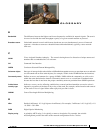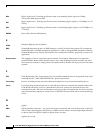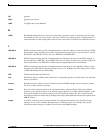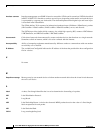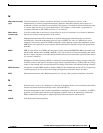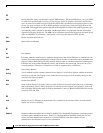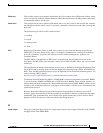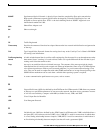
Glossary
GL-8
Cisco ASR 1000 Series Aggregation Services Routers MIB Specifications Guide
OL-15161-06
Security model
A security model is an authentication strategy that is set up for a user and the group in which the user
resides. A security level is the permitted level of security within a security model. A combination of a
security model and a security level determines which security mechanism is employed when handling
an SNMP packet.
SEEPROM
Serial Electrically Erasable Programmable Read Only Memory
SR
Short Reach
SIP
SPA Interface Processor. Line card that carries the SPAs. Also referred to as MSP (Modular Services
Processor and functions as a carrier card for shared port adapters)
SNMPv1
The Simple Network Management Protocol: An Internet standard, defined in RFC 1157. Security is
based on community strings. SNMPv1 uses a community-based form of security. The community of
managers who are able to access the agent MIB is defined by an IP address Access Control List and
password.
SNMPv2
The community-string based administrative framework for SNMPv2. SNMPv2c is an update of the
protocol operations and data types of SNMPv2p (SNMPv2 classic), and uses the community-based
security model of SNMPv1.
SNMPv2c support includes a bulk-retrieval mechanism and more detailed error message reporting to
management stations. The bulk-retrieval mechanism supports the retrieval of tables and large quantities
of information, minimizing the number of round-trip transmissions required. SNMPv2c improved error
handling support includes expanded error codes that distinguish different kinds of error conditions;
these conditions are reported through a single error code in SNMPv1. Error return codes now report the
error type. Three kinds of exceptions are also reported:
• no such object exceptions
• no such instance exceptions
• end of MIB view exceptions
SNMPv3
SNMPv3—Version 3 of SNMP. SNMPv3 uses the following security features to provide secure access
to devices:
• Message integrity—Ensuring that a packet has not been tampered with in transit.
• Authentication—Determining that the message is from a valid source.
• Encryption—Scrambling the contents of a packet to prevent it from being learned by an
unauthorized source.
SNMP agent
A software component in a managed device that maintains the data for the device and reports the data,
as needed, to managing systems. The agent and MIB reside on the routing device (router, access server,
or switch). To enable the SNMP agent on a managed device, you must define the relationship between
the manager and the agent.
SNMP manager
A system used to control and monitor the activities of network hosts using SNMP. The most common
managing system is called a Network Management System (NMS). The term NMS can be applied to
either a dedicated device used for network management, or the applications used on a
network-management device. A variety of network management applications are available for use with
SNMP. These features range from simple command-line applications to feature-rich graphical user
interfaces (such as the CiscoWorks2000 line of products).



